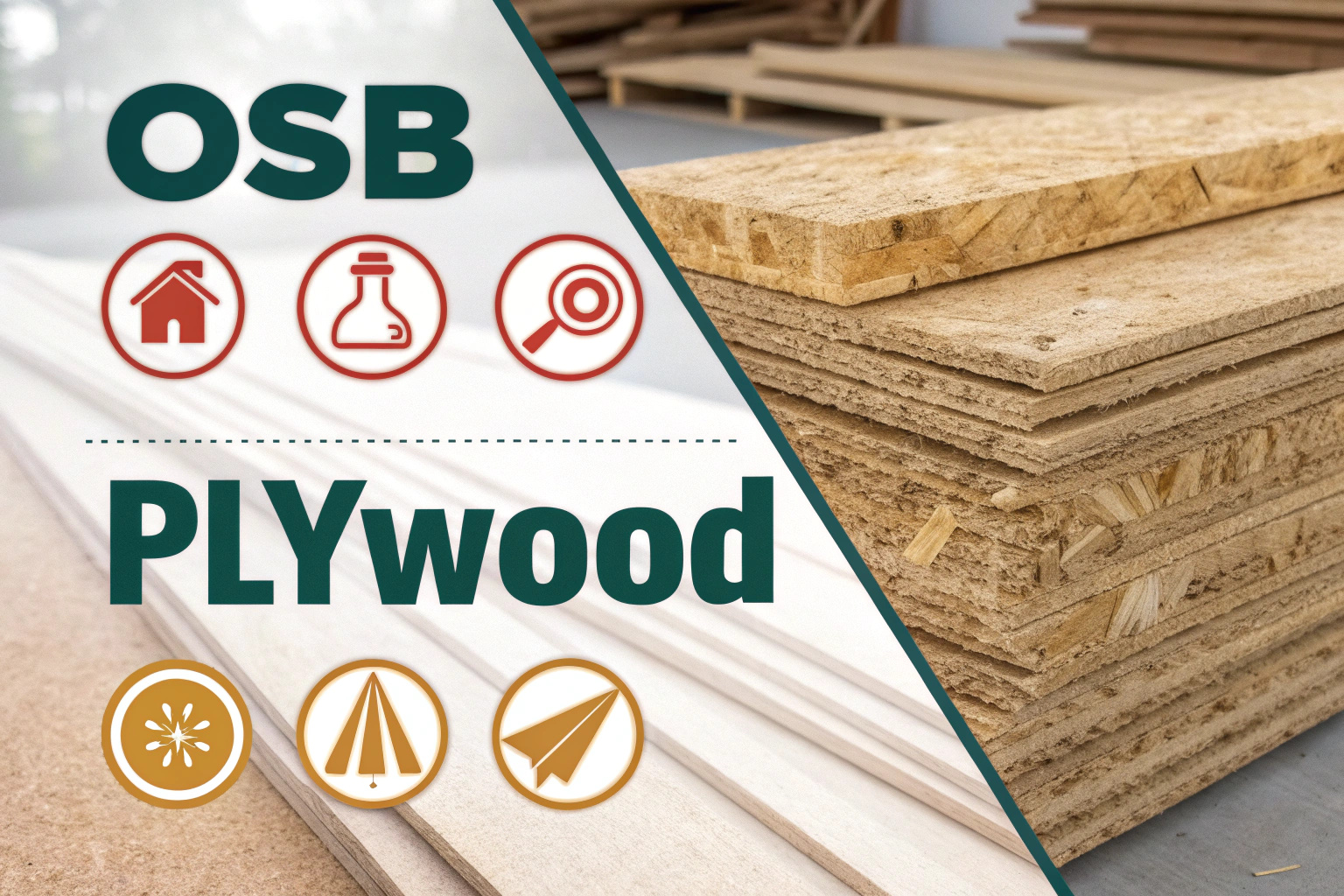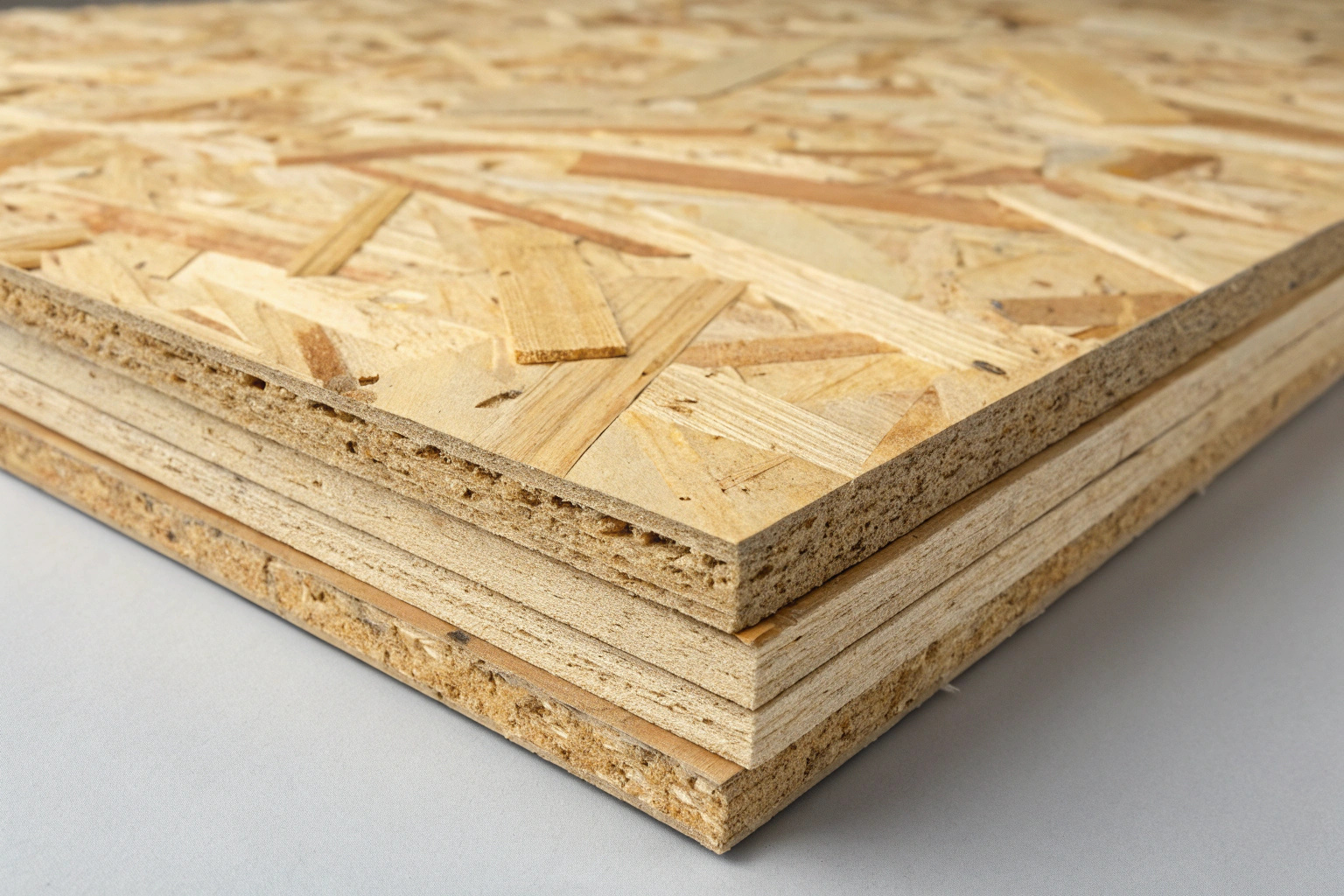
OSB and plywood are both popular building materials, but they have key differences in structure, strength, and application. Let’s explore these distinctions and help you decide which one suits your project best.
OSB and plywood differ mainly in the way they are manufactured and their respective applications. While plywood uses thin layers of wood veneer, OSB is made from larger wood strands. Discover their differences, advantages, and which is better for your project.
When choosing between OSB (Oriented Strand Board) and plywood, it’s important to understand their differences, as each material has unique properties and advantages. Whether you’re building a house, crafting furniture, or working on a DIY project, knowing the distinctions between OSB and plywood will help you make the right choice. In this article, we’ll take a closer look at what sets OSB and plywood apart, how they’re made, and where they are best used.
✖
While plywood is typically stronger in terms of bending resistance, OSB can have superior shear strength and is generally better for specific applications like flooring and roofing.
✖
OSB is often more affordable but has different strength and moisture resistance properties than plywood, making it unsuitable for some high-end applications, like cabinetry or fine furniture.
What is OSB?

OSB, or Oriented Strand Board, is a type of engineered wood product made from wood strands, flakes, or fibers that are bonded together with resin and pressed into sheets. The wood strands are oriented in layers to create a strong, durable board. The manufacturing process gives OSB its signature look: a textured surface with visible strands of wood running in different directions.
OSB is primarily used for construction purposes, such as flooring, wall sheathing, and roofing. Its strength and cost-effectiveness make it a popular choice for builders and contractors. Though its surface is not as smooth as plywood, it provides excellent structural integrity when used in the right applications.
What is Plywood?
Plywood is a type of manufactured wood made by layering thin sheets of wood veneer, known as plies, and bonding them with adhesive. The plies are usually stacked with alternating grain directions, which gives plywood strength and resistance to warping. Plywood’s smooth, finished surface makes it an ideal material for projects requiring a high-quality aesthetic, such as cabinetry, furniture, and interior walls.
Plywood comes in various grades, with higher-quality plywood featuring fewer knots and imperfections. This versatility makes plywood a widely used material in both construction and DIY projects.
Key Differences Between OSB and Plywood
1. Manufacturing Process
- OSB: OSB is made from larger strands or flakes of wood that are arranged in layers. The strands are oriented in specific directions to increase strength, and resin is used to bond the pieces together.
- Plywood: Plywood is made from thin layers of wood veneer that are cross-laminated and glued together with the grain direction alternating for each layer. The process ensures the plywood’s strength and resistance to bending.
2. Strength and Durability
- OSB: OSB is generally stronger in terms of shear strength, meaning it can resist forces that try to push the surface of the board in different directions. However, it may not have the same bending strength as plywood.
- Plywood: Plywood tends to be stronger in terms of bending resistance, making it ideal for applications like flooring and furniture where flexibility and load-bearing capacity are important.
3. Moisture Resistance
- OSB: While OSB has decent moisture resistance due to its resin treatment, it is more susceptible to swelling and degradation when exposed to prolonged moisture. This can affect its strength and appearance.
- Plywood: Plywood generally has better moisture resistance, particularly exterior-grade plywood that uses waterproof glue. It performs better in environments where exposure to water is a concern.
4. Cost
- OSB: OSB is usually more affordable than plywood because the manufacturing process uses larger wood strands, which are less expensive than veneer layers. As a result, OSB is a cost-effective choice for large-scale construction projects.
- Plywood: Plywood is typically more expensive due to its more labor-intensive manufacturing process, especially for higher grades and specialty types.
5. Aesthetic and Finish
- OSB: The surface of OSB is rough and textured, which makes it unsuitable for projects that require a smooth, finished surface. It’s often used in hidden structural applications or covered with paint or other finishes.
- Plywood: Plywood has a smooth surface and is available in various grades. Higher-quality plywood is ideal for projects where aesthetics are important, such as cabinetry, flooring, or decorative elements.
Advantages of OSB
Cost-Effective
OSB is a more affordable material compared to plywood. It provides a budget-friendly option for large-scale construction projects, especially when the material will be hidden behind finishes or cladding.
Good Structural Strength
OSB offers excellent shear strength, which makes it ideal for applications like wall sheathing, flooring, and roofing. Its strength helps distribute loads evenly, making it a solid choice for structural elements.
Availability
OSB is widely available and comes in large sheets, making it an easy-to-source material for builders. Its widespread use in the construction industry also means it’s often available in a variety of sizes and thicknesses.
Environmentally Friendly
OSB is considered a more sustainable option than plywood because it uses wood strands and smaller pieces of wood that might otherwise go unused in plywood manufacturing. This helps reduce waste and supports sustainable forestry practices.
Advantages of Plywood
Superior Strength and Versatility
Plywood’s alternating grain structure makes it highly resistant to bending and warping. It is a versatile material used in both structural and decorative applications, such as walls, roofs, furniture, and cabinetry.
Better Moisture Resistance
Plywood, especially exterior-grade plywood, is more resistant to moisture than OSB. This makes it a better option for use in environments where exposure to water is frequent, such as in bathrooms, kitchens, and outdoor projects.
Smooth Finish for Aesthetic Projects
Plywood has a smooth surface, making it ideal for projects where a finished appearance is important. It can be easily stained, painted, or veneered to create beautiful, high-quality surfaces.
Longer Lifespan
Due to its superior moisture resistance and strength, plywood generally lasts longer than OSB, especially in applications exposed to the elements or heavy wear.
Applications of OSB and Plywood
OSB:
- Wall Sheathing: Used in construction to cover the exterior walls of buildings.
- Flooring: Used as a base layer under flooring materials like carpet or tile.
- Roofing: OSB is used for roof decking, providing a sturdy surface for roofing materials.
- Siding: OSB is often used for exterior siding in residential and commercial buildings.
Plywood:
- Furniture and Cabinetry: Plywood is ideal for building high-quality furniture and cabinets.
- Flooring: Plywood is commonly used for subflooring or in decorative hardwood floors.
- Interior Walls: Plywood panels are used in both residential and commercial interiors for decorative wall treatments.
- Boat Building: Marine-grade plywood is resistant to water and commonly used in boat construction.
Which One Should You Choose?
- Choose OSB if you’re working on a large-scale construction project like framing, roofing, or wall sheathing. OSB is cost-effective and offers good structural strength, making it ideal for hidden applications where the material won’t be visible.
- Choose Plywood if you need a more aesthetically pleasing material, especially for visible surfaces like furniture, cabinetry, or flooring. Plywood’s superior strength, moisture resistance, and smooth finish make it ideal for both structural and decorative applications.
Conclusion
Both OSB and plywood have their strengths and ideal use cases. OSB is a great, budget-friendly option for structural applications like wall sheathing, flooring, and roofing, whereas plywood is better suited for projects where strength, moisture resistance, and a smooth finish are necessary. By understanding their differences, you can select the right material for your project, ensuring durability, cost-effectiveness, and the desired aesthetic.
